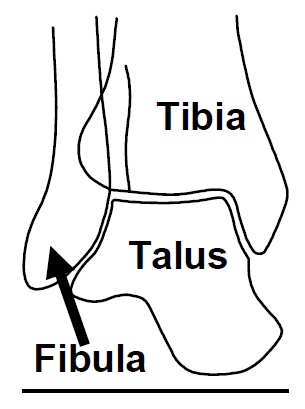 Ankle fractures are common and can often be treated non-surgically. Fractures typically involve a combination of injuries to the fibula, the tibia and the surrounding ligaments. Surgery is recommended to patients who need something more than casting. This includes fractures that are unstable and those with larger displacement of the bone fragments. Surgery corrects acute deformity, improves function, decreases risks of post-traumatic arthritis and speeds return to work and sports.
Ankle fractures are common and can often be treated non-surgically. Fractures typically involve a combination of injuries to the fibula, the tibia and the surrounding ligaments. Surgery is recommended to patients who need something more than casting. This includes fractures that are unstable and those with larger displacement of the bone fragments. Surgery corrects acute deformity, improves function, decreases risks of post-traumatic arthritis and speeds return to work and sports.
A surgically treated fracture will heal faster than those treated non-surgically. While some risks increase, the early return of function (healing as early as four weeks versus an average of 10 weeks) is very attractive to some patients. I have an open-ended discussion with my patients regarding this choice and will routinely default to non-surgical treatment when it is safe.
Have you suffered an ankle fracture and are wondering about the right course of treatment?
If so, let Dr. Silverman help.
What Happens Before Ankle Fracture Surgery?
The surgical center will provide specific instructions for how you can prepare for surgery and what to expect when you arrive at the clinic. On the day of surgery you will receive regional anesthesia known as a popliteal nerve block. This is a procedure performed by the anesthesiologist prior to surgery. You will be placed on your stomach and injected with Novocain-like medication around the nerve in your leg. This gives complete pain relief that lasts for 12 to 36 hours. Patients report extraordinary satisfaction with this type of anesthesia. You will be given sedatives during the surgery. Some people require general anesthesia. All patients receive antibiotics just before surgery to help prevent infection.
What Happens During Ankle Fracture Surgery?
A tourniquet will be placed around your thigh, and incisions are strategically placed. The fractured bones are put back together and plates, screws, or wires are used to fix the bones in place. Ligaments and tendons are repaired if needed. X-Rays taken during the surgery confirm the correction. The wounds are closed with staples and sutures.
What Happens After Ankle Fracture Surgery?
You will be permitted to leave the post-anesthesia center once your anesthesiologist is satisfied that have recovered. Patients with more severe injuries require an inpatient stay. During this recovery time your family member may take your prescription to the nearest pharmacy. You will be given crutches. Take your narcotic pain control medications during this early post-operative period. Remember post operative pain is much easier to control with prevention. Call to schedule your post-operative visit for two weeks after surgery.
Ankle Fracture Reconstruction General Recovery Timeline
This timeline is a general guideline. Your post-operative course may vary.
| Elevation | 23 hours / day for 3 days; then keep elevated as needed. Swelling may last over 4 months. |
| Motion | Move your toes when the block resolves. This will decrease pain and swelling, and improve healing. Plan to begin ankle motion at 2 weeks when the cast comes off. |
| Walking | Unless you are told otherwise, you may begin partial weight bearing at 3 weeks in the fracture brace or cast. Once the fracture heals, as identified by x-ray, you may wean out of the brace (this varies depending on the fracture). |
| Bathing | Keep the cast dry. Use a DryPro vacuum sealed waterproof cast protector. There are generally no restrictions once the cast is removed. |
| Dressing | After 2 weeks apply a Bioskin Aftercare Ankle Brace when out of the boot. This helps control swelling. Use the silicone sheeting to flatten the scars. |
| Pain Control | Expect to use strong narcotics for the first 3-5 days. Wean off as soon as you are comfortable using Tylenol. Do not use Advil, Motrin, or other NSAIDS during the first 10 days as they can slow bone healing. |
| Work | Return depends on specific demands. It is safe to return to sedentary work at 10 days post-op. Return to heavy labor may take 2-3 months or more. |
| Driving | Patients with left foot surgery may drive an automatic transmission. Patients with right foot surgery must wait until healing is adequate and they feel safe. |
Routine Clinic Visits
| 2 weeks | X-ray, cast and staple removal; apply a fracture brace or a new cast. |
| 6 weeks | X-ray, earliest time of bone healing to permit time out of boot and begin Physical therapy. The time to return for your next visit varies significantly. |
| 3-4 months | Return for recheck. Strength improves over the next year. Minimal feelings of discomfort may linger, your overall comfort level improves over a year. |
| ********** | If at any time during your post-operative period you notice any drainage or foul odor from your incision, a temperature of more than 100.4 degrees and/or increased swelling or tenderness, you should contact our office. |
For more helpful tips, check out these rehab exercise videos that will help you recover, or reach out to Dr. Silverman for more information!